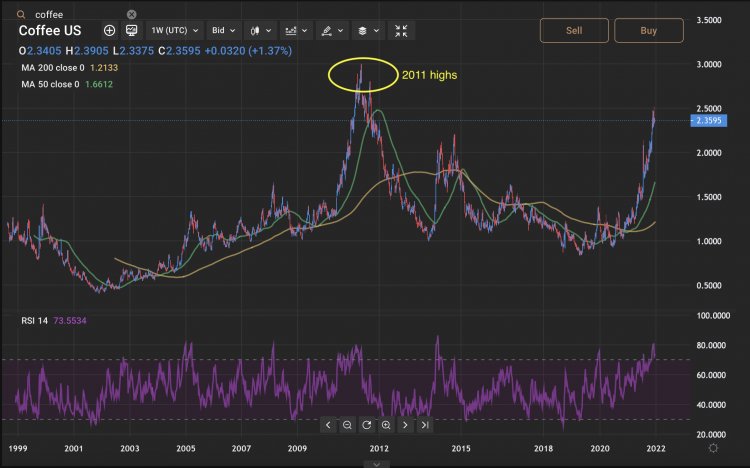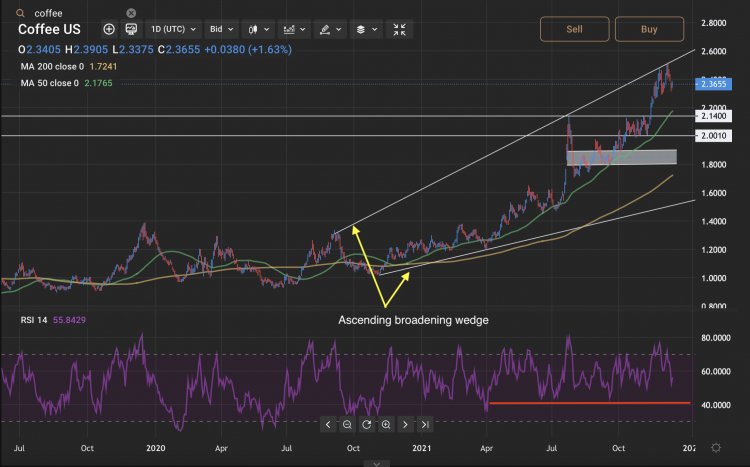Coffee is one of the second-highest return on investment among soft commodities in 2021, with prices now 80% higher than at the start of the year, just behind oats (+93%), reaching highest since January 2012.
The spot “KC” coffee contract – the reference for the Arabica variety – jumped to 235 US cents/lb from 160 US cents/lb in mid-July, or about 50%, due to reduced output in Brazil. , the world’s largest producer of Arabica coffee, and supply chain disruptions affect the global coffee trade, particularly in Asia.
Brazil experienced its most severe frost since 1994 in July, wiping out about 150,000-200,000 hectares of trees in the country’s coffee acreage map, or 11% of the nation’s arable land. this.
Meanwhile, according to Research and Markets, the global coffee market is expected to reach $144.68 billion by 2025, with an average growth rate of 7.60% per year from 2021 to 2025, due to Increased demand from emerging countries and limited output due to unusual weather.
Technically, the spot price of coffee has been trading between two non-parallel trend lines, forming a so-called ascending extension ‘wedge’ – a technical chart pattern emerged. in a bull market and shows the potential of a strong reversal pattern.
Long term weekly coffee price chart

Price chart of spot Arabica coffee for 1 week to December 13, 2021. Source: Capital.com
Analysis of the fundamentals of the coffee market
When it comes to coffee, Brazil is by far the largest producer in the world, and weather conditions in Latin America are important to its supply.
The International Coffee Organization estimates that 169.6 million bags of coffee (1 bag = 60 kg) will be produced globally in 2020, of which Brazil accounts for about 40% of production. World coffee consumption is estimated to increase slightly in volume, reaching 166.34 million bags in 2020/21, higher than 164.2 million bags in 2019/20.
The weather in Brazil has improved, traffic congestion and high freight rates have eased, but things are not back to normal.
Cooxupé, the world’s largest coffee cooperative and Brazil’s number one exporter, recently lowered its coffee export forecast for 2021 to 4.8 million bags from 6.5 million bags. Previously, due to congestion in the transport system and reduced output, the export volume also decreased. To solve the problem of not being able to deliver goods to customers, Cooxupé had to change the method of transportation, packing coffee in 1,000 kg bags to load on ships carrying dry, bulk goods, instead of carrying them by containers, although this method caused team costs go up a lot.
The coffee outlook for 2022 depends heavily on global economic growth and the evolution of the Covid-19 pandemic. A recent report by the International Monetary Fund (IMF) revised its forecast for global economic growth down to 5.9% in 2021 and 4.9% in 2022. According to the organization, the downgrade The projections for 2021 represent contractions in advanced economies – partly due to supply disruptions – and low-income developing countries, largely due to factors related to The pandemic is getting worse.
In the short term, the supply and demand dynamics of coffee could actually improve, compared to the past few months. The reimposition of Covid-related restrictions by countries around the world to combat the spread of the Omicron variant virus could impact coffee consumption, while weather conditions in the Southern Hemisphere are improved. improvement, as Brazil approaches summer, could help maintain supply.
Technical analysis of coffee prices

1-day spot Arabica coffee price chart to December 13, 2021. Source: Capital.com
Since September 2021, the spot price of coffee has been trading in an ascending expansion wedge pattern as discussed above. On the daily chart, the simple moving average of coffee prices over the last 50 days is 7.5% below current prices, while the 200-day moving average is 25 percent lower. % of the spot price. Since April, the 14-day relative strength index (RSI) has crossed 40, or more than doubled over that period, indicating that the market has fallen into overbought territory.
Arabica’s first major support is around 215 cents/lb, formerly a triple resistance and now also a level where the 50-day simple moving average crosses. If this support zone is broken, the possibility that coffee price will continue to fall to the 180-190 zone will increase.
Resistance is represented by the upper line of the ascending expanding Wedge. If the psychological 250 level is broken, a further rise to 275 US cents, the highest since August 2011.
Reference: Capital
